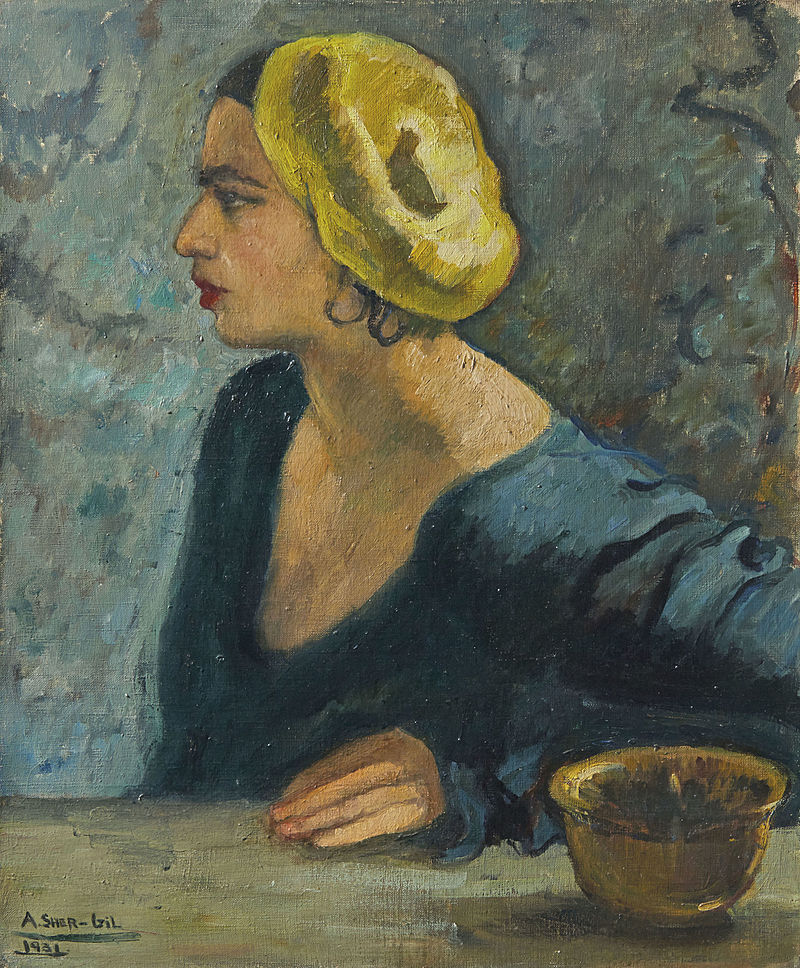Movement/Style: A mixture of Western modernism and traditional Indian art styles
Country: Hungary and India
Years: 1913 – 1941
Well, who was she?
Amrita Sher-Gil was a Hungarian-Indian painter who was born in Hungary and moved to India later in her life. She’s known as a pioneer of modern Indian art, and is one of the most influential Indian women artists in history. Her work portrayed the lives of women, especially Indian women, and her style evolved from Western influences to classical Indian influences.
Sher-Gil’s early career was influenced by European art styles, especially those in 1930s Paris, and an early work of hers, Young Girls from 1932, won her a gold medal at the Grand Salon in Paris. She also got admitted as an Associate Member of Société Nationale des Beaux-Arts for this work, and was the first Indian artist to do this.
In the 1930s she began, however, to feel a great longing to return to her Indian roots. She once wrote: “I can only paint in India. Europe belongs to Picasso, Matisse, Braque…. India belongs only to me”. She embarked on a quest to explore Indian art traditions that would last for the rest of her life. In 1934, she started traveling to India more and more, and eventually moved there permanently in 1941. Throughout this time, her style was rapidly evolving as she consciously moved towards more Indian art influences.
Her subject matters focused on Indian women, and people living in poverty. She once described her artistic mission: “to interpret the lives of Indians and particularly of the poor Indians pictorially, to paint the silent images of infinite submission and patience, to depict the angular brown bodies, strangely beautiful in their ugliness, to reproduce on canvas the impression their sad eyes created on me”.
Although she unfortunately died very early, at the age of twenty-eight, her art—with its strong colours, expressive emotions, and powerful figures—has left an extremely strong legacy, with the Indian government having declared her works to be National Art Treasures.
Give me the gossip!
Sher-Gil married her Hungarian first cousin, Dr. Victor Egan, when she was 25, and they then moved to India together. It seems she was engaged to Egan in 1931, but then had an affair with Yusuf Ali Khan, broke off her engagement to Egan and got engaged to Khan, but then broke that off as well. There were rumors that at the time she was having an affair with Egan.
She might also have struggled with same-sex desires, once writing “I thought I would start a relationship with a woman when the opportunity arises.” There were rumours about the potentially sexual/romantic nature of her relationship with painter Marie Louise Chassany, to the point where her mother actually confronted her about it, but she denied this in a letter to her mother. She also had a sexual relationship with pianist Edith Lang (apparently Chassany once walked in on them, according to Victor Egan).
In terms of her political views, even though her family had close ties to the British Raj, she was sympathetic to the Indian National Congress, a political party that was led by Mahatma Gandhi at the time and which became the leader of the Indian independence movement.
As mentioned above, Sher-Gil sadly died incredibly young, at just 28 years of age. She became very ill and slipped into a coma, dying around midnight, on 6 December 1941. We still don’t know why exactly she died, but a failed abortion is one of the theories. Her mother actually accused Egan of murdering her. Her last work was left unfinished by her just prior to her death in December 1941 and she left behind a large amount of works (and, of course, a lasting legacy).
Give me a quick selection of her art!
Group of Three Girls, 1935
As I mentioned above, Sher-Gil painted a lot of women, and specifically Indian women. The above painting is a beautiful example of that. What’s noteworthy about this one is that the women are looking a bit downcast and melancholy. This was probably a choice she made because she wanted to reflect the hard lives of poor women in India, and it was also something rarely seen in other portrayals of Indian women in the 1930s, which usually showed them to be happy and obedient.

Amrita Sher-Gil, Self Portrait as Tahitian, 1934, oil on canvas, Collection of Navina and Vivan Sundaram
Self Portrait as Tahitian, 1934
The above is one of my personal favourites as it draws on the Paul Gauguin’s paintings of Tahitian women. I’ve written before about the problematic, exoticising aspects of these paintings, and to me this feels like someone who might have been the object of a fetishising male gaze taking control of that gaze and choosing how to portray herself. Compared to Gauguin’s paintings, her expression is a lot more somber and severe.
Two Girls, 1939
As I mentioned previously, there is a possibility that Sher-Gil was attracted to women, and there were plenty of rumours about her strong bond with painter Marie Louise Chassany. Some art critics, including her nephew Vivan Sundaram, believed that the above piece was a representation of their relationship and longing for each other.
Where can I go if I want more information?
- If you’re in India, much of her work is in the collection of the National Gallery of Modern Art in New Delhi.
- Earlier this year (2018), many decades after her death, Sher-Gil finally got an obituary in the New York Times.
- Indian contemporary artist Vivan Sundaram—who, as I mentioned above, is the nephew of Amrita Sher-Gil—has written books about her life. He also created a work called Re-take of ‘Amrita’, a series of digital photomontages based on archival photographs from the Sher-Gil family. He speaks about her life here on TateShots.








Michael
Thank you Ellen for writing about this fascinating painter, of whom I was totally unaware.